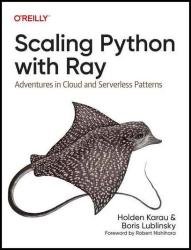 Название: Scaling Python with Ray: Adventures in Cloud and Serverless Patterns (Final Release)
Название: Scaling Python with Ray: Adventures in Cloud and Serverless Patterns (Final Release)Автор: Holden Karau, Boris Lublinsky
Издательство: O’Reilly Media, Inc.
Год: 2023
Страниц: 269
Язык: английский
Формат: True/Retail PDF EPUB
Размер: 10.19 MB
Serverless computing enables developers to concentrate solely on their applications rather than worry about where they've been deployed. With the Ray general-purpose serverless implementation in Python, programmers and data scientists can hide servers, implement stateful applications, support direct communication between tasks, and access hardware accelerators.
In this book, authors Holden Karau and Boris Lublinsky show you how to scale existing Python applications and pipelines, allowing you to stay in the Python ecosystem while avoiding single points of failure and manual scheduling. If your data processing has grown beyond what a single computer can handle, this book is for you.
Software engineering now plays a central role in Machine Learning (ML), and teams and organizations that successfully leverage ML often build large in-house infrastructure teams to support the distributed systems necessary for scaling ML applications across hundreds or thousands of machines. So at the same time that ML is growing in its capabilities and becoming more relevant for a variety of businesses, it is also becoming increasingly difficult to do because of the significant infrastructure investment required to do it. To get to a state where every business can leverage and get value out of ML, we will have to make it far easier to apply in practice. This will mean eliminating the need for developers to become experts in distributed systems and infrastructure.
This goal, making scalable computing and scalable ML easy to do, is the purpose of Ray and the reason that we created Ray in the first place. This is a natural continuation of a progression in computing. Going back a handful of decades, there was a time when developers had to program in Assembly Language and other low-level machine languages in order to build applications, and so the best developers were the people who could perform low-level memory optimizations and other manipulations. That made software development difficult to do and limited the number of people who could build applications. Today, very few developers think about Assembly. It is no longer on the critical path for application development, and as a result, far more people can develop applications and build great products today. The same thing will happen with infrastructure. Today, building and managing infrastructure for scaling Python applications and scaling ML applications is on the critical path for doing ML and for building scalable applications and products. However, infrastructure will go the way of Assembly Language. When that happens, it will open up the door and far more people will build these kinds of applications.
Scaling Python and Ray can serve as an entry point for anyone looking to do ML in practice or looking to build the next generation of scalable products and applications. It touches on a wide variety of topics, ranging from scaling a variety of important ML patterns, from deep learning to hyperparameter tuning to reinforcement learning. It touches on the best practices for scaling data ingest and preprocessing. It covers the fundamentals of building scalable applications. Importantly, it touches on how Ray fits into the broader ML and computing ecosystem.
Written by experienced software architecture practitioners, Scaling Python with Ray is ideal for software architects and developers eager to explore successful case studies and learn more about decision and measurement effectiveness. This book covers distributed processing (the pure Python implementation of serverless) and shows you how to:
Implement stateful applications with Ray actors
Build workflow management in Ray
Use Ray as a unified platform for batch and streaming
Implement advanced data processing with Ray
Build microservices with Ray
Implement reliable Ray applications
Скачать Scaling Python with Ray: Adventures in Cloud and Serverless Patterns (Final Release)